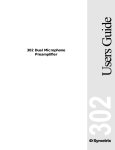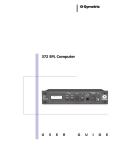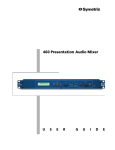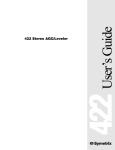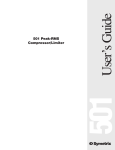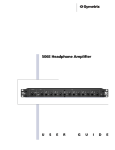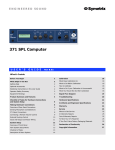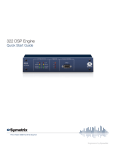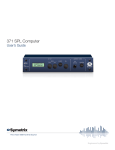Download 301 Low Distortion Comp/Limiter
Transcript
User s Guide 301 301 Low Distortion Comp/Limiter Table of Contents Introduction 1 Chapter 2 Operator Safety Summary 2 Chapter 3 Fast Setup 3 Chapter 4 Tutorial 4 Chapter 5 Front Panel Overview 7 Chapter 6 Rear Panel Overview 8 Chapter 7 Connecting to Other Gear 9 Chapter 8 Applications 12 Chapter 9 Troubleshooting 15 Chapter 10 Specifications 16 Chapter 11 Warranty and Service 17 Chapter 12 Declaration of Conformity 19 301 Chapter 1 Rev A.1, 15 June, 1998 Symetrix part number 53301-0A01 Subject to change at our whim and fancy without notice. '1998, Symetrix, Inc. All right reserved. Symetrix is a registered trademark of Symetrix, Inc. Mention of third-party products is for informational purposes only and constitutes neither an endorsement nor a recommendation. Symetrix assumes no responsibility with regard to the performance or use of these products. Under copyright laws, no part of this manual may be reproduced or transmitted in any form or by any means, electronic or mechanical, including photocopying, scanning, recording or by any information storage and retrieval system, without permission, in writing, from Symetrix, Inc. i 6408 216th St. SW Mountlake Terrace, WA 98043 USA Tel (425) 778-7728 Fax (425) 778-7727 Email: [email protected] Chapter 1 Introduction Congratulations on your purchase of the Symetrix 301 LOW DISTORTION COMP/ LIMITER. The Symetrix 301 represents an enormous breakthrough in compression technology, allowing, for the first time, compression without added distortion from the compression process. The single-channel 301 gives you the ability to apply compression, to smooth out dynamic levels, or to apply limiting, when you need hard-line control over signal levels. The Symetrix 301 does all this, while occupying only half the width of one rack space. from getting so loud that speakers and horns are damaged, and can provide protection to human hearing from damage due to excessive sound levels. For ease of operation, the Symetrix 301 provides a selectable automatic attack/release mode, which generates predetermined compression attack and release characteristics that are designed to work well with most program material. For the more advanced user, the Symetrix 301 provides a selectable manual attack/release mode, which allows utmost control of the attack and release parameters, so that settings may be optimized to the user s taste. Whether you work with broadcast, recording, live sound reinforcement, paging or playback systems, compression and limiting are extremely valuable tools. Compression can smooth out vocal levels, to create a more pleasing sound, and to allow the audio engineer to squeeze every last decibel out of the available headroom. Compression can be used to give vocals and instruments, such as the bass guitar, more punch . Compression also helps to even out the different speaking levels of the various people making page announcements over a paging system. It helps to even out varying source levels (such as the differences in level between various CD s, or the difference in level between a CD player and a cassette tape player) in music playback systems. Whatever your audio needs, the Symetrix 301 offers compression and limiting power while utilizing innovative circuitry for unparalleled freedom from distortion. Only minimal space in your equipment rack is needed to contain this powerhouse unit. Limiting can protect the broadcast engineer from exceeding the broadcast level allowed by the FCC, and it can protect the recording engineer from having a recording ruined by an unexpected signal peak that drives the recording medium into distortion. Limiting also can protect live sound reinforcement, paging and playback systems Phone: (425) 778-7728 Fax: (425) 778-7727 Email: [email protected] Website: www.symetrixaudio.com COMPRESSOR/LIMITER THRESHOLD (dBu) ATTACK -10 50mS 301 LOW DISTORTION COMP/LIMITER -25 +5 25mS AUTOMATIC ATTACK/RELEASE 70mS OUTPUT RELEASE RATIO (X:1) .5 Sec 4 AUTOMATIC MANUAL .25 Sec 2 Sec GR +20 500uS 100mS 50mS 4 Sec 2.5 8 BYPASS GAIN (dB) 0 -3dB -6dB -12dB -40 301 We recommend that you read this manual coverto-cover. You will find the answers to most of your questions inside. However, if you are in a hurry, go directly to Chapter 3 (Fast Setup). It will get you started quickly. Should you have any comments or questions, please do not hesitate to contact us. Your calls and e-mail are always welcome. 10 -7.5 +7.5 CLIP -18dB -15 +15 PWR Front panel OUTPUT INPUT MANUFACTURED BY SYMETRIX INC. LYNNWOOD, WA USA POWER INPUT CONNECT TO SYMETRIX PS-3 OR PS-3E POWER SUPPLY ONLY. THIS PRODUCT CONTAINS NO USER SERVICABLE PARTS. FABRIQUÉ AUX E.-U. PAR SYMETRIX INC., LYNNWOOD, WASHINGTON. RÉFÉREZ TOUTE RÉPARATION À UN TECHNICIEN QUALIFIÉ. Rear panel 1 Operator Safety Summary The information in this summary is intended for persons who operate the equipment as well as repair personnel. Specific warnings and cautions are found throughout this manual wherever they may apply. The notational conventions used in this manual and on the equipment itself are described in the following paragraphs. Chapter 2 Caution Identifies information that, if not heeded, may cause damage to the 301 or other equipment in your system. Warning Identifies information that, if ignored, may be hazardous to your health or that of others. CAPITALS Controls, switches or other markings on the 301 s chassis. Boldface Strong emphasis. Equipment Markings CAUTION RISK OF ELECTRIC SHOCK DO NOT OPEN TO REDUCE THE RISK OF FIRE OR SHOCK DO NOT EXPOSE WARNING: ELECTRIC THIS EQUIPMENT TO RAIN OR MOISTURE DE CHOC ELECTRIQUE AVIS: RISQUE NE PAS OUVRIR SEE OWNERS MANUAL. VOIR CAHIER D’INSTRUCTIONS. No user serviceable parts inside. Refer servicing to qualified service personnel. Il ne se trouve a l’interieur aucune piece pourvant entre reparée l’usager. S’adresser a un reparateur compétent. The lightning flash with arrowhead symbol within an equilateral triangle is intended to alert the user of the presence of uninsulated dangerous voltage within the product’s enclosure that may be of sufficient magnitude to constitute a risk of electric shock to persons. 301 The exclamation point within an equilateral triangle is intended to alert the user of the presence of important operating and maintenance (servicing) instructions in the literature accompanying the 301 (i.e. this manual). Caution To prevent electric shock, do not use the polarized plug supplied with the 301 with any extension cord, receptacle, or other outlet unless the blades can be fully inserted. Terms Several notational conventions are used in this manual. Some paragraphs may use Note, Caution, or Warning as a heading. Certain typefaces and capitalization are used to identify certain words. These are: Note 2 Identifies information that needs extra emphasis. A Note generally supplies extra information to help you to better use the 301. Power source - This product is intended to operate from a power source that does not apply more than 255Vrms between the power supply conductors or between either power supply conductor and ground. A protective ground connection, by way of the grounding conductor in the power cord, is essential for safe operation. Danger from loss of ground - If the protective ground connection is lost, all accessible conductive parts, including knobs and controls that may appear to be insulated, can render an electric shock. In-line power supply - This product receives its operating power from the Symetrix PS-3 DC power supply. This is the only power supply approved for use with the product. Do not connect the product to any other in-line, or plug-in, transformer. The use of other power sources may cause damage to the equipment or present a shock hazard to the operator. Operating location - Do not operate this equipment under any of the following conditions: explosive atmospheres, in wet locations, in inclement weather, improper or unknown AC mains voltage, or if improperly fused. Stay out of the box - To avoid personal injury or injury to others, do not remove the product covers or panels. Do not operate the product without the covers and panels properly installed. Fast Setup Chapter 3 Fast First-Time Setup Follow these instructions to get your 301 up-and-running as quickly as possible. The intent of this section is fast setup. Refer to later chapters for explanation of the 301 s controls and functions. ≠ Connect the line-level signal source to the XLR input jack or Euroblock input connector. Connect the line-level signal return to the XLR output jack or Euroblock output connector. Additional information on the signal connections may be found on pages 10-11 of this manual. Connect the 301 s power supply to the power input of the 301 (the DIN plug end). Connect the 3-conductor AC plug end to an AC power source of the proper voltage and frequency, as marked on the rear of the unit. Caution: Failure to connect the 301 to the proper AC mains voltage may cause fire and/or internal damage. Warning: Lethal voltages are present inside the chassis. There are no user serviceable parts inside the chassis. Refer all service to qualified service personnel or to the factory. Make your initial control settings as follows: SWITCH/CONTROL SETTING THRESHOLD CONTROL AUTOMATIC ATTACK/RELEASE RATIO CONTROL GAIN CONTROL -10 (12 O CLOCK) I N position (AUTOMATIC) 2.5:1 (APPROX. 10 O CLOCK) 0 (12 O CLOCK) The individual ATTACK and RELEASE controls are not active when the AUTOMATIC ATTACK/RELEASE button is engaged in the In position. A factory preset for the attack and release times will be activated when the Automatic Attack/Release button is set In (Automatic mode). To use the 301 with the AUTOMATIC ATTACK/RELEASE button set to Manual mode, see Chapter 4, pg. 5 for information on using the individual ATTACK and RELEASE controls. 301 With the 301 s controls and switches now set according to the preceding section, the 301 should pass signal. Fast setup is complete. 3 Tutorial Chapter 4 Dynamics Processing Tutorial and 301 Functional Basics Audio signals possess several basic properties: amplitude or volume (measured in volts or dB), frequency or pitch (measured in Hertz), duration (measured in hours:minutes:seconds) and waveform (described graphically, like sine, square, triangle, or pulse). Complex signals like musical sounds are made up of simpler waveforms such as sine waves, mixed in the proper proportions. Signal processors allow you to manipulate various parameters of an audio signal. Equalizers change the amount of amplification given to different frequencies (a perfect amplifier increases the gain of all frequencies by the same amount). Dynamics processors - such as compressors, limiters, expanders and gates - change the dynamic range of audio signals. The dynamic range of an audio signal is the difference between its loudest and softest moments. For audio equipment, this is the difference between the noise floor (residual noise output, with no input signal) and peak clipping (the point at which the output clips or distorts). A hypothetical black-box having a noise floor of -90 dBu and a maximum peak output level of +24 dBu would have a dynamic range of 114 dB (+24 minus -90). Audio storage devices like tape machines have a much narrower dynamic range; a typical professional analog two-track tape machine may have a dynamic range of 65 to 70 dB. If you ve used an analog tape recorder before, then you are already familiar with the problem of setting recording level. Record too hot and you get distortion; record too cold and get noise in return. Many musical instruments have dynamic ranges that exceed that of most tape recorders. So, how do we squeeze a 80 or 90 dB signal into a 60 or 70 dB window? The answer lies in a common audio signal processor: the compressor. Compressors and Limiters A compressor or limiter monitors the level (or amplitude) of its input signal and reduces the gain of its output signal whenever its input signal level exceeds a predetermined level. The predetermined level is known as the threshold level and is usually set by a front-panel control. The amount by which the compressor lowers the output level is the compression ratio, and this parameter is usually set via a front-panel control as well. 301 Compression ratio refers to the ratio of the amount of change in signal level at the input versus the amount of change in signal level at the output of the device. Thus, if we apply an above-threshold signal increase of 10 dB to the input of a hypothetical compressor, and measure a 2 dB increase in the output signal, that compressor would have a compression ratio of 10:2, or 5:1 (reduce the fraction). Different compression ratios have different uses. Use lower ratios (5:1 or less) for smoothing out peaks in level, intermediate ratios (5:1 to 9:1) for leveling (making the signal level more or less constant), and higher ratios for limiting (putting an absolute ceiling on the signal level). Limiters are nothing more than compressors, but they utilize higher compression ratios (10:1 or higher). Limiters are typically used to stop occasional audio peaks which would otherwise cause overload or distortion. Typically a limiter is set (via its threshold control) so that it stays out of the way until a peak comes along. Ratio The compression ratio of the 301 determines how much the output changes in relation to a change in the input. A linear amplifier (like a simple preamp) has a ratio of 1:1 because a change of 1 dB at its input results in a 1 dB change at its output. A compressor alters the input/output relationship by its compression ratio. Thus a 20:1 ratio means that a 20 dB above-threshold change at the input results in a 1 dB change at the output. In other words, a very audible change at the input (20 dB) turns into a barely discernible change at the output (1 dB). 4 Compressors are not the only devices to have an input/output ratio. Any device that is capable of changing the input/output relationship can be said to have a ratio. Thus expanders, gates, compressors and limiters all fit this category. Gain versus Output Level The GAIN control compensates for signal level lost to compression. As an example, set the THRESHOLD control clockwise and set the RATIO control of the 301 for a 10:1 ratio. Now adjust the THRESHOLD control for 12 dB of gain reduction as viewed on the compressor s gain reduction display (labelled GR). The output level should be significantly lower than it was when the THRESHOLD control was counter-clockwise (i.e. when no compression was being applied). You supply the additional gain (make-up gain) by adjusting the GAIN control until the input and output signal levels match. Attack Time The speed at which a compressor begins to reduce output gain as an increasing input signal crosses the threshold level is determined by the setting of the attack time control. Situations in which you want the compressor to act quickly, such as peak limiting applications (for protection against overload and distortion), call for fast attack times. Fast attack times are also appropriate when the signal being compressed begins abruptly and/or forcefully, such as when a drum is struck sharply. Keep in mind that the pumping compressor sound that many people find objectionable usually happens when the fastest attack and release times are used, in combination with heavy compression. For overall level-smoothing, such as for general speech and music applications, slightly slower attack time settings are usually used. When you use slower attack time settings, the compressor won t begin to act as quickly as it would with faster attack settings, but the resulting compression will be more natural-sounding, musical and less intrusive. Release Time For compressors, the no-signal state is unity gain (passing the signal straight through the compressor, with no change in gain). Compressors also apply unity gain to any signal whose level is below threshold. The release time control determines how long it will take for the compressor to return to unity gain, once the input signal has fallen below the compression threshold. Generally, peak limiting is associated with short release times and compression or leveling is associated with longer release times. Setting the Threshold Control The THRESHOLD control sets the audio signal level at which the compressor/limiter begins working. The processor begins working once the signal has exceeded that threshold level. The THRESHOLD control setting, working in conjunction with the RATIO setting, also determines the degree or amount of gain reduction. When the RATIO control is set for a ratio greater than 1:1, rotating the THRESHOLD control counter-clockwise (towards -40) results in increasing amounts of compression. For most compressor applications, moderate amounts of gain reduction are all that is required, 3-9 dB at the most. If you are using the compressor to minimize level changes of a wide dynamic range of program material (automatic level control), then higher amounts of gain reduction are needed. In typical compressor applications, program material with a very wide dynamic range calls for higher amounts of gain reduction than program material with less dynamic range. Note With higher amounts of gain reduction, slower release times are recommended. 5 301 Most dynamics processing equipment has a control marked RELEASE on the front panel. This control refers to release time, and it affects the length of time required for the gain to recover to the no-signal state (when no signal is applied to the input). The release time control allows tailoring the expander s or compressor s recovery time to the program material. Interpreting the Display The LED display on the 301 s front panel indicates a parameter called gain reduction. Simply stated, the gain reduction indication shows how far the gain or amplification was reduced from unity. Another way of looking at this is: if the gain reduction display says 12 dB of gain reduction, switching the unit to bypass will result in a 12 dB increase in the output level. For most applications, just make certain that you never see the CLIP LED illuminate. The CLIP LED is a warning light which comes on to indicate that the signal level in the output stage is too high and distortion is imminent. 301 Caution 6 The CLIP LED monitors only the output stage of the 301. It is possible to clip the 301 s input by applying a signal that is too high in level without the CLIP LED illuminating. Do not exceed the maximum input level shown in the specifications listed on pg. 16. Chapter 5 Front Panel Overview The Compressor/Limiter Controls THRESHOLD control - The THRESHOLD control varies the compressor threshold from -40 dBu to +20 dBu. The compressor threshold is the level that the input signal must reach before the compressor becomes active. When the input signal exceeds this threshold, the compressor will reduce the output gain by the amount determined by the compressor RATIO control setting. THRESHOLD (dBu) ATTACK -10 50mS -25 ATTACK control - The ATTACK control sets the speed at which the compressor reduces the output gain when the input signal increases above the threshold level. AUTOMATIC ATTACK/RELEASE button - When the AUTOMATIC ATTACK/RELEASE button is set to the In position, the individual front panel ATTACK and RELEASE controls are disabled, and the 301 applies factory preset attack and release times to the program material. These attack and release settings are intended for general use and they will sound good on most material. For specific applications, or whenever operator control of the attack and release times is desired, set the AUTOMATIC ATTACK/RELEASE button to the Manual ( Out ) position. This setting enables the front panel ATTACK and RELEASE controls so that the operator can use them to select his or her own settings. +5 -40 AT 25mS +20 70mS 500uS 100mS COMPRESSOR/LIMITER AUTOMATIC ATTACK/RELEASE 0mS RELEASE .5 Sec AUTOMATIC MANUAL .25 Sec 2 Sec 50mS S 4 Sec RELEASE control - The RELEASE control sets the speed at which the compressor restores the gain when an instantaneous above-threshold drop in the input signal occurs. The compressor release time can be varied from 50 milliseconds to 4 seconds. RATIO control - The RATIO control determines the amount of compression that occurs for a given above-threshold change in the input level. The ratio that is being controlled is the ratio between an above-threshold change in the input level and the resulting change in the output level. If the RATIO control is set to 10:1, then a 10 dB above-threshold change in the input level would result in only a 1 dB change in the output level. Higher ratios are used where tighter control is desired, such as when you want to control peaks in the audio signal. Lower ratios are used for gentle smoothing of levels. RATIO (X:1) GR 4 -3dB 2.5 -6dB 8 -12dB BYPASS -18dB 10 301 LED display - The LED display indicates the amount by which the output level has been reduced by the compressor (i.e. gain reduction). The Output Controls GAIN control - The GAIN control sets the final output signal level. This control can be used to increase the output level, up to +15 dB, or to decrease the output level, by as much as -15 dB. This control can be used, if needed, to restore signal level lost by compression or limiting, to make up for the 6dB drop in output level that occurs when you connect an unbalanced cable to the 301 s output, or to reduce the 301 s output level to prevent overdriving the input stage of the next device in the signal chain. Note The unity gain position (0) of the GAIN control is referenced to the balanced output connector. If you are using the unbalanced output, unity gain occurs when the GAIN control is set to +6 dB. Unbalanced operation is not recommended. OUTPUT GAIN (dB) 0 -7.5 +7.5 CLIP -15 +15 CLIP LED - The CLIP LED should never be on solidly. It is usually all right if the CLIP LED flashes occasionally, on peaks in the program material. If you see the CLIP LED light, monitor your final signal destination to be sure that you are not creating distortion by running audio levels that are too hot. 7 Rear Panel Overview Chapter 6 Power Connection 7-pin DIN connector - Connect the 7-pin DIN plug end of a Symetrix PS-3 (117V) or PS-3E (230V) here. Connect the AC power connector end of the PS-3 or PS-3E to an AC power source that is of the correct voltage and frequency as marked on the PS-3 or PS-3E. MANUFACTURED BY SYMETRIX INC. LYNNWOOD, WA USA POWER INPUT CONNECT TO SYMETRIX PS-3 OR PS-3E POWER SUPPLY ONLY. THIS PRODUCT CONTAINS NO USER SERVICABLE PARTS. FABRIQUÉ AUX E.-U. PAR SYMETRIX INC., LYNNWOOD, WASHINGTON. RÉFÉREZ TOUTE RÉPARATION À UN TECHNICIEN QUALIFIÉ. Audio Output Connections XLR-3 male connector - wired Pin 1=ground, Pin 2=high(+) and Pin 3=low(-). Use this connector when you need a balanced XLR output. The nominal signal level here is +4 dBu. This balanced connector is wired in parallel with the Euroblock connector. Note OUTPUT Connecting an unbalanced cable here will result in an output level that is 6dB lower than the output level you get if you use a balanced cable. Euroblock connector - wired as shown on the rear of the 301 and in the drawing below. This balanced connector is wired in parallel with the XLR connector. OUTPUT POWER INPUT INPUT CONNECT TO SYMETRIX PS-3 OR PS-3E POWER SUPPLY ONLY. MANUFACTURED BY SYMETRIX INC. LYNNWOOD, WA USA THIS PRODUCT CONTAINS NO USER SERVICABLE PARTS. FABRIQUÉ AUX E.-U. PAR SYMETRIX INC., LYNNWOOD, WASHINGTON. RÉFÉREZ TOUTE RÉPARATION À UN TECHNICIEN QUALIFIÉ. Balanced Male XLR output Pin 1=Not Connected Pin 2 = High Pin 3 = Low Shield Tab = Not Connected Pin 1= Circuit Ground Pin 2 = High Pin 3 = Low Shield Tab = Not Connected 2 3 1 (Shielding provided by 301) 1 3 2 301 (Shielding provided by Destination) Balanced Female XLR input Audio Input Connections XLR-3 female connector - This connector is wired Pin 1=ground, Pin 2=high(+) and Pin 3=low(-). This balanced connector is wired in parallel with the Euroblock connector. Euroblock connector - wired as shown on the rear of the 301 and in the drawing above. This balanced connector is wired in parallel with the XLR connector. Note 8 Connecting an unbalanced cable to the 301 s input will result in an input level that is at least 6dB lower than the input level you get if you use a balanced cable. Unbalanced operation is not recommended. INPUT Chapter 7 Connecting to Other Gear Matching Levels vs Matching Impedances In any audio equipment application, the question of matching inevitably comes up. Without digging a hole any deeper than absolutely necessary, we offer the following discussion to (hopefully) clarify your understanding of the subject. Over the years, we have all had impedance matching pounded into our heads. This is important only for vintage audio systems, power amplifiers, and RF. Technically speaking, the reason is power transfer, which reaches a maximum when source and load are matched. Modern audio systems are voltage transmission systems and source and load matching is not only unnecessary, but undesirable as well. Vintage audio systems operate at 600 ohms (or some other impedance value), and must be matched, both at their inputs and at their outputs. Generally speaking, if you are dealing with equipment that uses vacuum tubes, or was designed prior to 1970, you should be concerned about matching. These units were designed when audio systems were based on maximum power transfer, hence the need for input/output matching. Power amplifiers are fussy because an abnormally low load impedance generally means a visit to the amp hospital. Thus, it s important to know what the total impedance of the pile of speakers connected to the amplifier really is. RF systems are matched because we really are concerned with maximum power transfer and with matching the impedance of the transmission line (keeps nasty things from happening). Video signals (composite, baseband, or otherwise) should be treated like RF. Some folks seem to believe that balanced/unbalanced lines and impedances are related; or even worse that they are associated with a particular type of connector. Not so. Unbalanced signals are not necessarily high-impedance and balanced signals/lines are not necessarily low-impedance. Similarly, although 1/4 inch jacks are typically used for things like guitars (which are highimpedance and unbalanced), this does not predispose them to this use alone. After all, 1/4 inch jacks are sometimes used for loudspeakers, which are anything but high-impedance. Therefore, the presence of 3-pin XLR connectors should not be construed to mean that the input or output is lowimpedance (or high-impedance). The same applies to 1/4 inch jacks. Signal level is very important. Mismatch causes either loss of headroom or loss of signal-to-noise ratio. Thus, microphone inputs should only see signals originating from a microphone, a direct (DI) box, or an output designated microphone-level output. Electrically, this is in the range of approximately -70 to -20 dBm. Line inputs should only see signals in the -10 to +24 dBm/dBu range. Guitars, high-impedance microphones, and many electronic keyboards do not qualify as line-level sources. The impedance relation between outputs and inputs needs to be considered, but only in the following way - Always make sure that a device s input impedance is higher than the output source impedance of the device that drives it. Some manufacturers state a relatively high-impedance figure as the output impedance of their equipment. What they really mean is that this is the minimum load impedance that they would like their gear to see. In most cases, seeing a output impedance figure of 10,000 (10K) ohms or higher from modern equipment that requires power (batteries or AC) is an instance of this type of rating. If so, then the input impedance of the succeeding input must be equal to or greater than the output impedance of the driving device. Symetrix equipment inputs are designed to bridge the output of whatever device drives the input (i.e. to be greater than 10 times the actual source impedance). Symetrix equipment outputs are designed to drive 600-ohm or higher loads (600-ohm loads are an archaic practice that won t go 9 301 So, what is really important? Signal level, and (to a much lesser degree), the impedance relation between an output (signal source) and the input that it connects to (signal receiver). away). You don t need to terminate the output with a 600-ohm resistor if you aren t driving a 600ohm load. (If you don t understand the concept of termination, you probably don t need to anyway.) The two facts that you need to derive from this discussion are: Match signal levels for best headroom and signal-to-noise ratio. For audio, impedance matching is only needed for vintage equipment and power amplifier outputs. In all other cases, ensure that your inputs bridge your outputs (meaning the inputs are in the range of 2 to 200 times the output source impedance). Signal Levels The 301 is designed around studio/professional line levels: +4 dBu or 1.23 volts RMS. The unit is quiet enough to operate at lower signal levels such as those found in semi-pro or musical instrument (MI) equipment (-10 dBv or 300 millivolts). You may also use a matching device, such as the Symetrix 303 Interface Amplifier to boost -10dBV signals to +4dBu. This gives you the added benefit of providing a balanced signal to the 301. I/O Impedances The 301 is designed to interface into almost any recording studio or sound reinforcement application. This includes: 600-ohm systems where input and output impedances are matched. Modern bridging systems where inputs bridge and outputs are low source impedances (voltage transmission systems). The 301 s input impedance is 20-kilohms balanced. The inputs may be driven from any balanced source capable of delivering at least -10 dBV into the aforementioned impedances. The 301 s output impedance is 200 ohms balanced, 100 ohms unbalanced. The output line driver delivers +22 dBu into 600-ohm balanced loads or +18 dBu into 600-ohm unbalanced loads. Input and Output Connections 301 The illustration on the next page shows how to connect the 301 to balanced and unbalanced sources and loads. Please remember that unbalanced operation is not recommended. If you must operate the 301 from unbalanced sources, run a 2-conductor shielded cable (that s two conductors plus the shield) from the source to the 301. At the source, connect the cable connector s sleeve to one conductor (this will be the - or the low conductor) and connect the tip to the remaining + or high conductor, leaving the shield unconnected. At the 301 s input connect the shield to the chassis connection and the cable s (-) and (+) to the corresponding 301 input connections. This is the preferred method as it makes best use of the 301 s balanced input (even though the source is unbalanced). The other alternative shown in the illustration converts the 301 s balanced input into an unbalanced input at the input connector. This works, but is more susceptible to hum and buzz than the preferred method. There is no level difference between either method. You can drive unbalanced loads with the 301 s outputs by using the XLR connector with pin 3 left open. In an emergency (the show must go on), you can ground pin 3, but if you have the choice...leave it open. If you must ground pin 3, it must be grounded at the 301, rather than at the other end of the cable. The price, regardless of whether or not pin 3 is grounded is 6 dB less output level. If your system is wired with pin 3 hot, and you are driving an unbalanced load, pin 2 must float. 10 Balanced Terminal Strip (Shielding provided by 301) (Wire Shield Not Connected) Input Two Conductor Shielded Cable Balanced Female XLR (Shielding provided by 301) 1 3 2 Pin 1=Not Connected Pin 2 = High Pin 3 = Low Shield Tab = Not Connected Input Two Conductor Shielded Cable TRS Plug (Shielding provided by 301) Tip = High Ring = Low Sleeve = Not Connected (Wire Shield Not Connected) TIP RING SLEEVE Input Two Conductor Shielded Cable TS Plug (Shielding provided by 301) Tip = High Sleeve = Low (Wire Shield Not Connected) TIP SLEEVE Input Two Conductor Shielded Cable RCA Plug (Shielding provided by 301) 301 Input Tip = High Sleeve = Low (Wire Shield Not Connected) Two Conductor Shielded Cable Balanced Male XLR (Shielding provided by Destination) Pin 1= Circuit Ground Pin 2 = High Pin 3 = Low Shield Tab = Not Connected Output 2 3 1 Two Conductor Shielded Cable TS Plug (Shielding provided by Destination) Tip = High Sleeve = Shield (Wire Low Not Connected) TIP SLEEVE Output Two Conductor Shielded Cable 11 Applications Chapter 8 Here are a few applications for which the 301 is an optimal processing tool. The following applications make one assumption: settings for the threshold control(s) are a function of each individual system s actual operating level. Wherever specific threshold settings are mentioned, they are referenced to either a particular gain reduction level as indicated by the meter, or to a 0 dBu input level. Vocal Level Smoothing This is one of the main uses for a compressor/limiter in recording, broadcast, and live sound. A compressor adds fullness to almost any vocal by gently suppressing the loudest components of the audio signal. This allows the listener to hear the quieter, subtle sounds more clearly. Recording and live sound engineers use this technique to help position the lead vocal out in front of the backing instruments in a stereo mix. Use a ratio between 2:1 and 5:1. Adjust the threshold until you see 6-9 dB of gain reduction on the highest peaks. Remember that this is just a starting point because all vocalists and speakers have a different delivery. Let your ears be the guide. COMPRESSOR/LIMITER THRESHOLD (dBu) ATTACK -10 50mS -25 +5 AUTOMATIC ATTACK/RELEASE 70mS 25mS OUTPUT RELEASE RATIO (X:1) .5 Sec 4 AUTOMATIC MANUAL .25 Sec 2 Sec GR 0 -3dB 2.5 8 -6dB -7.5 +20 500uS 50mS 100mS 4 Sec BYPASS -18dB 10 +7.5 CLIP -12dB -40 GAIN (dB) -15 +15 P Constant Level Paging 301 All too often, paging announcements are either sub-audible, or distorted. The problem is the result of changing input levels from different users (Timid Tom vs Sam Screamer) and unpredictable environmental circumstances. To optimize system levels for intelligibility without overload, use the compressor section to even out levels and to put a clamp on Sam Screamer. Set the compressor RATIO to 6:1 (one o clock position). Set the compressor THRESHOLD for 6 dB of gain reduction with normal paging levels. All normal signals will be slightly compressed, and really loud signals will be more heavily compressed. With these settings a soft voice will be audible, and the guy who thinks he has to shout won t be too loud, or cause distortion. 12 COMPRESSOR/LIMITER THRESHOLD (dBu) ATTACK -10 50mS -25 +5 25mS AUTOMATIC ATTACK/RELEASE 70mS OUTPUT RELEASE RATIO (X:1) .5 Sec 4 AUTOMATIC MANUAL .25 Sec 2 Sec GR 2.5 8 -6dB -12dB -40 +20 500uS 100mS 50mS 4 Sec BYPASS GAIN (dB) 0 -3dB 10 -18dB -7.5 +7.5 CLIP -15 +15 P Protection Limiting The 301 may also be used as a peak limiter. Limiting is generally considered to occur when you use a ratio of 10:1 or greater. Occasions for such settings include using the 301 to prevent the input to a recording deck from being overloaded or to protect speakers from overload. (Stereo operation would require two 301 s.) For limiting applications, set the RATIO control to 10:1. [Make sure the AUTOMATIC ATTACK/ RELEASE button is set Out (manual mode)]. Use a very fast attack time and a fast release time setting. Set the output GAIN control to 0 for unity gain, and set the THRESHOLD control so that gain reduction only occurs when the input signal level becomes dangerously high. When the signal is at lower levels, the 301 s compressor/limiter stays out of the way. Caution Remember that even with the RATIO control set to 10:1, the 301 still allows 1dB of increase in signal level at the output for every 10dB of above-threshold increase in the input signal. Be sure to set your threshold below the level at which distortion or damage could occur to allow for slight above-threshold increases in the output level. Note The Symetrix 301 allows you to apply either compression or limiting. You cannot use the 301 to apply compression and limiting at the same time. To apply both compression and limiting simultaneously, you would need two 301 s or one Symterix 501 Peak-RMS Compressor/Limiter. Stereo signals would require four 301 s , two 501 s or one Symetrix 565E Dual Compressor/Limiter/Expander. COMPRESSOR/LIMITER ATTACK -10 50mS -25 +5 25mS AUTOMATIC ATTACK/RELEASE 70mS OUTPUT RELEASE RATIO (X:1) .5 Sec 4 AUTOMATIC MANUAL .25 Sec 2 Sec GR 2.5 8 -6dB -12dB -40 +20 500uS 100mS 50mS 4 Sec BYPASS GAIN (dB) 0 -3dB 10 -18dB -7.5 +7.5 CLIP -15 +15 P 301 THRESHOLD (dBu) 13 14 301 Chapter 9 Troubleshooting Troubleshooting Chart SYMPTOM PROBABLE CAUSE No output Check cables and connections. Are inputs driven by outputs, and outputs driving inputs? Verify cables, source and load by patching input and output connections together, at the unit. Check for AC power presence. Check output by plugging headphones into the output connector. Hum or buzz in output Check input and output connector wiring (refer to page 11). Ground loop: check related system equipment grounding. Are all system components on the same AC ground? Distortion Check input signal. Is it too hot, or is it already distorted? Check the output loading. It should be above 600 ohms. Is the input of the device following the 301 clipping? Is the input of the device following the 301 a line-level input (it should be)? Is something else clipping? Are your attack and release settings too fast? Try lengthening the release setting. If you still have distortion, try lengthening the attack setting. Noise (hiss) Check input signal levels. The 301 is intended to operate at or near line level (+4dBu is nominal). Make sure that the signal you are feeding to the 301 is a line level signal, not mic level. Make sure that all systems components are on the same AC ground. Check gain settings on downstream equipment. The system gain structure should be such that the 301 operates at or near unity gain. Is the input signal already noisy? No LED display Is the unit plugged in? Is the AC outlet OK? 301 The GR (gain reduction) LED will not light unless the RATIO control is set for something higher that a 1:1 ratio (Bypass)? Is the THRESHOLD control set low enough for the input signal to exceed the threshold? If you have selected a long attack setting, try a shorter one. 15 Specifications Chapter 10 Architects and Engineers Specifications The 301 Low Distortion Comp/Limiter shall be a single-channel model that controls the dynamic range of wide-range, wideband audio signals, providing compression or peak limiting. The unit shall occupy one-half rack space (ßU). The threshold of the compressor section shall be adjustable over a range of -40 dBu to +20 dBu via a front panel control. The input-to-output ratio will be adjustable from 1:1 to 10:1. Control of the compressor attack time and release time shall be set by the front panel control. A factory preset attack time and release time may be selected by a front panel button labelled Automatic Attack/Release. The compressor section will have a dedicated four-segment LED ladder that will display the gain reduction amount. The inputs shall be active balanced bridging designs terminated with an XLR jack and a Euroblock connector (both wired in parallel). The input circuitry shall incorporate RFI filters. The outputs shall be active balanced designs having equal source impedances and terminated with an XLR jack and a Euroblock connector (both wired in parallel). The balanced inputs shall accommodate +20 dBu (balanced) signals without distortion, and the balanced outputs shall be capable of delivering +22 dBm (balanced) into a 600ohm load. Overall frequency response shall be 10 Hz to 60 kHz (+0 dB, -3 dB). THD+N shall be less than 0.02% measured under the following conditions: +4 dBu input, +4 dBu output, 20 Hz to 20 kHz, 30kHz low-pass filter, 0 dB gain reduction. Residual noise output shall be no greater than -90 dBu balanced, measured with a 20 kHz noise bandwidth, input terminated in 600 ohms. The unit shall be capable of operating by means of a Symetrix PS-3 or PS-3E external power supply connected to 117V nominal AC (95 to 130V), 50/60 Hz or 230V nominal AC, 207 to 253V AC, 50 Hz where applicable. The unit shall be a Symetrix, Inc. model 301 Low Distortion Comp/Limiter. 301 Specifications Input/Output Maximum Input Level Maximum Output Level +20dBu Balanced +22dBu Balanced +18dBu Unbalanced 20k Ohms Balanced, 10k Ohms Unbalanced 200 Ohms Balanced, 100 Ohms Unbalanced Greater than 40dB Input Impedance Output Impedance CMRR Performance Data Frequency Response 10Hz to 60kHz, +0, -3 dB Dynamic Range 115dB (difference of max output and noise floor) THD+Noise <.008%, +4dBu in, +4dBu out, 0dB gain reduction, 20 Hz to 20 kHz, 30 kHz low-pass filter Gain Control +/-15dB center detent Output Noise -90dBu measured at balanced output, input terminated in 600 Ohms, 20kHz low-pass Compressor Type RMS responding Attack Time 500µS to 100mS Release Time 50 mS to 4 S Threshold -40dBu to +20dBu Ratio Bypass (1:1) to 10:1 16 Connections Input Output Polarity Power In Physical Size (hwd) Shipping Weight Electrical Power Requirements XLR, Euroblock XLR, Euroblock pin 2 of XLR is hot 7 pin DIN ˚ rack unit 1.75 x 8.5 x 6.5 in., 4.445 x 21.59 x 15.875 cm. 4.5 lbs 117V nominal, 95 to 130V AC, 50 to 60 Hz 230V nominal, 207 to 253V AC, 50 Hz In the interest of continuous product improvement, Symetrix, Inc. reserves the right to alter, change, or modify these specifications without prior notice. ©1998, Symetrix, Inc. All rights reserved. Chapter 11 Warranty and Service 301 Limited Warranty Symetrix, Inc. expressly warrants that the product will be free from defects in material and workmanship for one (1) year. Symetrix’s obligations under this warranty will be limited to repairing or replacing, at Symetrix’s option, the part or parts of the product which prove defective in material or workmanship within one (1) year from date of purchase, provided that the Buyer gives Symetrix prompt notice of any defect or failure and satisfactory proof thereof. Products may be returned by Buyer only after a Return Authorization number (RA) has been obtained from Symetrix. Buyer will prepay all freight charges to return the product to the Symetrix factory. Symetrix reserves the right to inspect any products which may be the subject of any warranty claim before repair or replacement is carried out. Symetrix may, at its option, require proof of the original date of purchase (dated copy of original retail dealer’s invoice). Final determination of warranty coverage lies solely with Symetrix. Products repaired under warranty will be returned freight prepaid by Symetrix via United Parcel Service (surface), to any location within the Continental United States. At Buyer’s request the shipment may be returned via airfreight at Buyer’s expense. Outside the Continental United States, products will be returned freight collect. Inc. expressly disclaims any IMPLIED warranties, including fitness for a particular purpose or merchantability. Symetrix’s warranty obligation and buyer’s remedies hereunder are SOLELY and exclusively as stated herein. The foregoing warranties are in lieu of all other warranties, whether oral, written, express, implied or statutory. Symetrix, This limited warranty gives the buyer certain rights. You may have additional rights provided by applicable law. This Symetrix product is designed and manufactured for use in professional and studio audio systems and is not intended for other usage. With respect to products purchased by consumers for personal, family, or household use, Symetrix expressly disclaims all implied warranties, including but not limited to warranties of merchantability and fitness for a particular purpose. This limited warranty, with all terms, conditions and disclaimers set forth herein, shall extend to the original purchaser and anyone who purchases the product within the specified warranty period. Warranty Registration must be completed and mailed to Symetrix within thirty (30) days of the date of purchase. Limitation of Liability The total liability of Symetrix on any claim, whether in contract, tort (including negligence) or otherwise arising out of, connected with, or resulting from the manufacture, sale, delivery, resale, repair, replacement or use of any product will not exceed the price allocable to the product or any part thereof which gives rise to the claim. In no event will Symetrix be liable for any incidental or consequential damages including but not limited to damage for loss of revenue, cost of capital, claims of customers for service interruptions or failure to supply, and costs and expenses incurred in connection with labor, overhead, transportation, installation or removal of products or substitute facilities or supply houses. 17 301 Symetrix does not authorize any third party, including any dealer or sales representative, to assume any liability or make any additional warranties or representation regarding this product information on behalf of Symetrix. Servicing the 301 If you have determined that your 301 requires repair services and you live outside of the United States, please contact your local Symetrix dealer or distributor for instructions on how to obtain service. If you reside in the U.S. then proceed as follows: Before sending anything to Symetrix, contact our Customer Service Department for a return authorization (RA) number. The telephone number is (425) 778-7728 or email: [email protected] In-warranty Repairs To get your 301 repaired under the terms of the warranty: 1. Call us for an RA number. 2. Pack the unit in its original packaging materials. 3. Include your name, address, daytime telephone number, and a brief statement of the problem. 4. Write the RA number on the outside of the box. 5. Ship the unit to Symetrix, freight prepaid. We do not accept freight collect shipments. Repairs made in-warranty will cost you only one-way freight charges. We ll prepay the return (surface) freight. 301 If you send us your product in substandard packaging, we will charge you for factory shipping materials. If you don t have the factory packaging materials, please use an oversized carton, wrap the unit in a plastic bag, and surround it with bubble-wrap. Pack the box full of Styrofoam peanuts. Be sure there is enough clearance in the carton to protect the rack ears (you wouldn t believe how many units are returned with bent ears). We will return the unit in Symetrix packaging. Of course, if the repair is due to operator error, parts and labor will be charged. In any event, if there are charges for the repair costs, you will pay for the return freight. All charges will be COD unless you have made other arrangements (prepaid, Visa or Mastercard). Out-of-warranty Repairs If the warranty period has passed, you ll be billed for all necessary parts, labor, packaging materials, and freight charges. Please remember, you must call for an RA number before sending the unit to Symetrix. 18 Chapter 12 Declaration of Conformity Declaration of Conformity We, Symetrix Incorporated, 6408 216th St. SW, Mountlake Terrace, Washington, USA, declare under our sole responsibility that the product: 301 Low Distortion Comp/Limiter to which this declaration relates, is in conformity with the following standards: EN 60065 Safety requirements for mains operated electronic and related apparatus for household and similar general use. EN 50081-1 Electromagnetic compatibility - Generic emission standard Part 1: Residential, commercial, and light industry. EN 50082-1 Electromagnetic compatibility - Generic immunity standard Part 1: Residential, commercial, and light industry. The technical construction file is maintained at: Symetrix, Inc. 6408 216th St. SW Mountlake Terrace, WA, 98043 USA 301 The authorized representative located within the European Community is: World Marketing Associates P.O. Box 100 St. Austell, Cornwall, PL26 6YU, U.K. Date of issue: June 15, 1998 Place of issue:Mountlake Terrace, Washington, USA Authorized signature: Dane Butcher, President, Symetrix Incorporated. 19 301 301 301 24 Symetrix, Inc. 6408 216th St. SW Mountlake Terrace, WA, 98043 USA Tel: (425) 778-7728 Fax: (425) 778-7727 Website: http://www.symetrixaudio.com Email: [email protected]
























